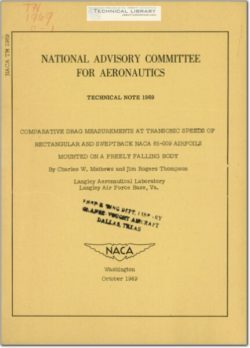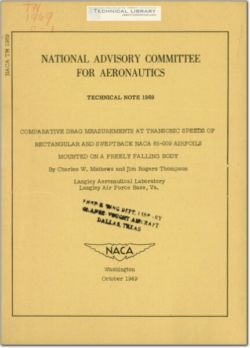NACA-TN-1969

- Version
- 139 Downloads
- 25.49 MB File Size
- 1 File Count
- December 4, 2015 Create Date
- December 4, 2015 Last Updated
National Advisory Committee for Aeronautics, Technical Notes - Comparative Drag Measurements at Transonic Speeds of Rectangular and Sweptback NACA 65-009 Airfoils Mounted on a Freely Falling Body

Directly comparable drag measurements of an airfoil with a
conventional rectangular plan form and an airfoil with a sweptback plan
form mounted on a freely falling body have been made. Both airfoils
had NACA 65—009 sections and were identical in span, frontal area, and
chord perpendicular to the leading edge. The sweptback plan form incor—
porated a sweepback angle of #50. The data obtained have been used to
establish the relation between the airfoil drag_coefficients and the
free-stream Mach number over a range of Mach.numbers from 0.90 to 1.27.
The results of these measurements indicate that the drag of the
sweptback plan form is less than 0.3 that of the rectangular plan form
at a Mach number of 1.00, and less than O.h that at a Mach number
of 1.20.
Recent interest in aerodynamic shapes and configurations which will
afford minimum drag at transonic velocities has led to the present
series of tests in which the variation of drag coefficient with Mach
number is determined during the free fall of a test body from high
altitude. The first series of tests on freely falling bodies was
reported in reference 1. The present paper reports results of two free-
fall tests conducted in June l9h5 as an initial experimental check on
the lowhdrag characteristics of swept wings at transonic speeds as
suggested by Jenes in reference 2. The data obtained from these tests
provide a direct comparison of the drag of an airfoil having a rectan—
gularoplan form with that of a similar airfoil having a sweepback angle
of h5.
The results of this investigation are presented as curves showing
the variation of drag Coefficient with Mach number.
Test airfoils and bodies. The general arrangements of the two test
bodies are shown in the photographs (fig. 1) and the details'and dimen—
sions are shown on the line drawing (fig. 2). Both the airfoil with the
conventional rectangular plan form and the airfoil with the sweptback
plan form had equal frontal areas and spans and inCorporated NACA 65-009
sections of equal chord perpendicular to the leading edge. This airfoil
section was selected as representative of those now being considered for
use on high speed aircraft.
| File | Action |
|---|---|
| 1449789138wpdm_naca-tn-1969.pdf | Download |
Comment On This Post